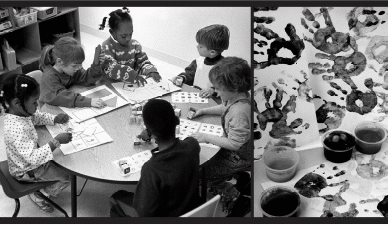NHES Topical Interview ECPP
National Household Education Surveys Program (NHES: 2011/2012) Field Test
NHES 2011 alternate ECPP
NHES Topical Interview ECPP
OMB: 1850-0768
OMB No. 1850-0768 Approval Expires 08/31/2010
The National Household Education Survey Our Children’s Future: A Survey of Young Children’s Care and Education |

Thank you for helping us with this survey. Based on the information we received from your household in your last survey, we’re asking you to complete this final step.

S
U.S.
Department of Education
National
Center for Education Statistics
Instructions
Please answer all the survey questions thinking about this child or youth.
|
We are authorized to collect this information by Section 9543, 20 US Code. You do not have to provide
the information requested. However, the information you provide will help the Department of Education’s
ongoing efforts to learn more about the educational experiences of children and families. There are no
penalties should you choose not to participate in this study. Your answers may be used only for statistical
purposes and may not be disclosed, or used, in identifiable form for any other purpose except as required
by law (Section 9573, 20 US Code). Your responses will be combined with those from other participants
to produce summary statistics and reports.
This survey is estimated to take an average of 20 minutes, including time for reviewing instructions and
completing and reviewing the collection of information. An agency may not conduct or sponsor, and a
person is not required to respond to, a collection of information unless it displays a currently valid OMB
control number. Send comments regarding this burden estimate or any other aspect of this collection of
information, including suggestions for reducing this burden, to: Andrew Zukerberg, National Center for
Education Statistics, U.S. Department of Education, 1990 K Street NW, Room 9036, Washington, DC
20006-5650. Do not return the completed form to this address.
1 |
► Thank you for your help with the previous survey your household completed.
► Answer all the survey questions thinking about the child listed below:
► Care Your Child Receives from Relatives
 These
questions ask about different types of child care this child may
now receive on a regular
basis
from someone other than his/her parents or guardians.
These
questions ask about different types of child care this child may
now receive on a regular
basis
from someone other than his/her parents or guardians.
1. Is this child now receiving care from a relative other than a parent or guardian on a regular basis, for example, from grandparents, brothers or sisters, or any other relatives?
N

GO TO question 17
oY
 es
es
2. Are any of these care arrangements regularly scheduled at least once a week?
N

GO TO question 17
oY
 es
es
3. These next questions are about the care that this child receives from the relative who provides the most care. How is that relative related to this child?
M ark
ONE
only.
ark
ONE
only.
Grandmother/Grandfather
Aunt /Uncle
Brother /Sister
Another relative
4 . How
old is the relative who provides the most care to this child?
. How
old is the relative who provides the most care to this child?

age
5. Is this care provided in your home or another home?
Own home
Other home
Both
6. How many days each week does this child receive care from this relative?
| __|
days each week
__|
days each week
7. How many hours each week does this child receive care from this relative?
| __|__|
hours each week
__|__|
hours each week
8. How old was this child in years and months when this particular regular care arrangement with this relative began?
|
 __
years months
__
years months
9. What language does this relative speak most when caring for this child?
English
Spanish
A language other than English or Spanish
English and Spanish equally
English and another language equally
1 0. Will
this relative care for this child when the child is…
0. Will
this relative care for this child when the child is…
|
|
No ▼ |
Yes ▼ |
a. |
Sick but does not have a fever? |
|
|
b. |
Sick and has a fever? |
|
|
11. Is there any charge or fee for the care this child receives from this relative, paid either by you or some other person or agency?
N

GO TO question 15
oY
 es
es
12. Do any of the following people, programs, or organizations help pay for this relative to care for this child?
M ark
ONE box for each item below.
ark
ONE box for each item below.
|
|
No ▼ |
Yes ▼ |
a. |
A relative of this child outside your household who provides money specifically for that care, not including general child support |
|
|
b. |
Temporary Assistance for Needy Families, or TANF |
|
|
c. |
Another social service, welfare, or child care agency |
|
|
d. |
An employer, not including a tax-free spending account for child care |
|
|
e. |
Someone else |
|
|
1 3. How
much does your household pay for this relative to care for this
child, not counting any money that may be received from others to
help pay for care?
3. How
much does your household pay for this relative to care for this
child, not counting any money that may be received from others to
help pay for care?
Write ‘0’ if your household does not pay this relative for care.
$


 .00
.00
Is that amount per…
Hour
Day
Week
Month
Year
Every 2 weeks
O

 ther
Specify:
ther
Specify:
14. How many children from your household is this amount for, including this child?
This child only
2 children
3 children
4 children
5 or more children
15. Does this child have any other care arrangements with a relative on a regular basis?
N

GO TO question 17
oY
 es
es
16. How many total hours each week does this child spend in those other care arrangements with relatives?
| __|_
hours each week
__|_
hours each week
► Care
Your Child Receives from Non-relatives
Care
Your Child Receives from Non-relatives
 The
next questions ask about any care this child receives from someone
not
related to him/her, either
in your home or someone else’s home.
This includes home child care providers or neighbors, but not day
care centers or preschools.
The
next questions ask about any care this child receives from someone
not
related to him/her, either
in your home or someone else’s home.
This includes home child care providers or neighbors, but not day
care centers or preschools.
17. Is this child now receiving care in your home or another home on a regular basis from someone who is not related to him/her?
N

GO TO question 35
oY
 es
es
18. Are any of these care arrangements regularly scheduled at least once a week?
N

GO TO question 35
oY
 es
es
19. These next questions are about the care that this child receives from someone who is not related to him/her who provides the most care.
Is this care provided in your own home or in another home?
Own home
Other home
Both
20. Does this person who cares for this child live in your household?
No
Yes
21. How many days each week does this child receive care from this person?
 days
each week
days
each week

22. How many hours each week does this child receive care from this person?
 hours
each week
hours
each week
23. How old was this child in years and months when this particular regular care arrangement with this person began?

 years
months
years
months
24. Was this care provider someone you already knew?
No
Yes
25. Is this child’s care provider age 18 or older?
No
Yes
26. What language does this care provider speak most when caring for this child?
English
Spanish
A language other than English or Spanish
English and Spanish equally
English and another language equally
27. Will this care provider care for this child when this child is…
|
|
No ▼ |
Yes ▼ |
a. |
Sick but does not have a fever? |
|
|
b. |
Sick and has a fever? |
|
|
2 8. Would
you recommend this care provider to another parent?
8. Would
you recommend this care provider to another parent?
No
Yes
29. Is there any charge or fee for the care this child receives from this care provider, paid either by you or some other person or agency?
N

GO TO question 33
oY
 es
es
30. Do any of the following people, programs, or organizations help pay for this person to care for this child?
M ark
ONE box for each item below.
ark
ONE box for each item below.
|
|
No ▼ |
Yes ▼ |
a. |
A relative of this child outside your household who provides money specifically for that care, not including general child support |
|
|
b. |
Temporary Assistance for Needy Families, or TANF |
|
|
c. |
Another social service, welfare, or child care agency |
|
|
d. |
An employer, not including a tax-free spending account for child care |
|
|
e. |
Someone else |
|
|

31. How much does your household pay for this person to care for this child, not counting any money that may be received from others to help pay for care?
Write ‘0’ if your household does not pay this non-relative for care.
$


 .00
.00
Is that amount per…
Hour
Day
Week
Month
Year
Every 2 weeks
O

 ther
Specify:
ther
Specify:
32. How many children from your household is this amount for, including this child?
This child only
2 children
3 children
4 children
5 or more children
33. Does this child have any other home-based care arrangements on a regular basis with someone who is not a relative? Do not include arrangements at day care centers or preschools.
N

GO TO question 35
oY
 es
es
34. How many total hours each week does this child spend in those other care arrangements with non-relatives?
 hours
each week
hours
each week
► Day
Care Centers and Preschool Programs Your Child Attends
Day
Care Centers and Preschool Programs Your Child Attends
 The
next questions ask about any day care centers and early childhood
programs that this child attends. This does not include care
provided in a private home.
The
next questions ask about any day care centers and early childhood
programs that this child attends. This does not include care
provided in a private home.
.
35. Is this child now attending a day care center, preschool, or prekindergarten not in a private home?
N

GO TO question 54
oY
 es
es
36. Does this child go to a day care center, preschool, or prekindergarten, at least once each week?
N

GO TO question 54
oY
 es
es
37. The next questions ask about the program where this child spends the most time.
Is this child’s current program a day care program, a preschool program, or a prekindergarten program?
Day care
Preschool
Prekindergarten
38. Is this program a Head Start or Early Head Start program?
 Head
Start and Early Head Start are federally sponsored preschool
programs primarily for children from low-income families.
Head
Start and Early Head Start are federally sponsored preschool
programs primarily for children from low-income families.
No
Yes
Don’t know
3 9.
Where is this program located?
9.
Where is this program located?
M ark
ONE
only.
ark
ONE
only.
In a church, synagogue, or other place of worship
In a public elementary or secondary school
In a private elementary or secondary school
At a college or university
At a community center
At a public library
In its own building, office space, or storefront
Some other place
S
 pecify:
pecify:
40. Is this program run by a church, synagogue, or other religious group?
41. Is this program located at your workplace or this child’s other parent’s workplace?
No
Yes
42. How many days each week does this child go to this program?
 days
each week
days
each week
43. How many hours each week does this child go to this program?
 hours
each week
hours
each week
44. How old was this child in years and months when he/she started going to this particular program?

 years
months
years
months
45. What language does this child’s main care provider or teacher at this program speak most when caring for this child?
E
 nglish
nglishSpanish
A language other than English or Spanish
English and Spanish equally
English and another language equally
46. Would you recommend this program to another parent?
No
Yes
47. Does this program provide any of the following services to this child or your family?
M ark
ONE box for each item below.
ark
ONE box for each item below.
|
|
No ▼ |
Yes ▼ |
a. |
Hearing, speech, or vision testing |
|
|
b. |
Physical examinations |
|
|
c. |
Dental examinations |
|
|
d. |
Formal testing for developmental or learning problems |
|
|
e. |
Sick child care when this child is sick but does not have a fever |
|
|
f. |
Sick child care when this child is sick and has a fever |
|
|
48. Is there any charge or fee for this program, paid either by you or some other person or agency?
N

GO TO question 52
oYes
4 9. Do
any of the following people, programs, or organizations help pay for
this child to go to this program?
9. Do
any of the following people, programs, or organizations help pay for
this child to go to this program?
M ark
ONE box for each item below.
ark
ONE box for each item below.
|
|
No ▼ |
Yes ▼ |
a. |
A relative of this child outside your household who provides money specifically for that care, not including general child support |
|
|
b. |
Temporary Assistance for Needy Families, or TANF |
|
|
c. |
Another social service, welfare, or child care agency |
|
|
d. |
An employer, not including a tax-free spending account for child care |
|
|
e. |
Someone else |
|
|
50. How much does your household pay for this child to go to this program, not counting any money that you may receive from others to help pay for care?
Write ‘0’ if your household does not pay for this program.
$


 .00
.00
Is that amount per…
Hour
Day
Week
Month
Year
Every 2 weeks
O

 ther
Specify:
ther
Specify:
51. How many children from your household is this amount for, including this child?
T
 his
child only
his
child only2 children
3 children
4 children
5 or more children
52. Does this child have any other care arrangements at a day care center or preschool on a regular basis?
N

GO TO question 54
oY
 es
es
53. How many total hours each week does this child spend at those day care centers or preschools?
 hours
each week
hours
each week
► Continue with section 2.
2 |
54. Has this child ever attended a Head Start or Early Head Start program?
 Head
Start and Early Head Start are federally sponsored preschool
programs primarily for children from low-income families.
Head
Start and Early Head Start are federally sponsored preschool
programs primarily for children from low-income families.
No
Yes
Don’t know
55. What is the main reason your household wanted a care program for this child in the past year?
M ark
ONE box.
ark
ONE box.
To provide care when a parent was at work or school
To prepare child for school
To provide cultural or language learning
To make time for running errands or relaxing
Some other reason
Did not have care in the past year
5 6.
Do you feel there are good choices for child care or early
childhood programs where you live?
6.
Do you feel there are good choices for child care or early
childhood programs where you live?
No
Yes
Don’t know
57. How much difficulty did you have finding the type of child care or early childhood program you wanted for this child?
H
GO TO question 59
 ave
not tried
ave
not tried
to find care
Did not find the child care program you wanted
A lot of difficulty
Some difficulty
A little difficulty
No difficulty
58. How important was each of these reasons when you chose the child care arrangement or program where this child spends the most time?
a. The location of the arrangement?
Not at all important
A little important
Somewhat important
Very important
b. The cost of the arrangement?
Not at all important
A little important
Somewhat important
Very important
c . The
reliability of the arrangement?
. The
reliability of the arrangement?
Not at all important
A little important
Somewhat important
Very important
d. The learning activities at the arrangement?
Not at all important
A little important
Somewhat important
Very important
e. The child spending time with other kids his/her age?
Not at all important
A little important
Somewhat important
Very important
f. The times during the day that this caregiver is able to provide care?
Not at all important
A little important
Somewhat important
Very important
g. The number of other children in the child’s care group?
Not at all important
A little important
Somewhat important
Very important
► Continue with section 3, question 59 on the next page.
3 |
or
month. The
next questions ask about this child’s activities with family
members in the past week
The
next questions ask about this child’s activities with family
members in the past week
59. About how many books does this child have of his/her own, including those shared with brothers or sisters?


 number
of books
number
of books
60. How many times have you or someone in your family read to this child in the past week?
N

GO TO question 62
ot at all times
times
61. About how many minutes on each of those times did you or someone in your family read to this child?
 minutes
minutes
62. In the past week, how many times has anyone in your family done the following things with this child?
a. Told this child a story? (Do not include reading to this child.)
Not at all
1 or 2 times
3 or more times
b. Taught this child letters, words, or numbers?
Not at all
1 or 2 times
3 or more times

c. Sang songs with this child?
Not at all
1 or 2 times
3 or more times
d. Worked on arts and crafts with this child?
Not at all
1 or 2 times
3 or more times
63. In the past month, have you or someone in your family visited a library with this child?
No
Yes
64. In the past month, have you or someone in your family visited a bookstore with this child?
No
Yes
65. In the past week, how many days has your family eaten the evening meal together?
Write ‘0’ if none.
 days
days
► Continue with section 4 on the next page.

 These
next questions ask about things that different children do at
different ages. These things may or may not be true for this
child.
These
next questions ask about things that different children do at
different ages. These things may or may not be true for this
child.
66. Is this child under 2 years old or is he/she 2 years old or older?
U

GO TO question 74
nder 2 years2
 years or older
years or older
67. Can this child identify the colors red, yellow, blue, and green by name?
No
Yes, some of them
Yes, all of them
68. Can this child recognize the letters of the alphabet?
No
Yes, some of them
Yes, most of them
Yes, all of them
69. How high can this child count?
This child cannot count
Up to 5
Up to 10
Up to 20
Up to 50
Up to 100 or more
70. Can this child write his/her first name, even if some of the letters are backwards?
No
Yes

71. Does this child ever read or pretend to read storybooks on his/her own?
N

GO TO question 74
oY
 es
es
72. Does this child actually read the words written in the book, or does he/she look at the book and pretend to read?
P

 retends
to read
retends
to readA

GO TO question 74
ctually reads the written
words
Does both
73. When this child pretends to read a book, does it sound like a connected story, or does he/she tell what is in each picture without much connection between them?
Sounds like connected story
Tells what’s in each picture
Does both
Does neither
► Continue with section 5, question 74 on the next page.
5 |
74. In general, how would you describe this child’s health?
Excellent
Very good
Good
Fair
Poor
75.Has a health, education, or early intervention professional told you that this child has any of the following conditions?
M ark
ONE box for each item below.
ark
ONE box for each item below.
|
|
No ▼ |
Yes ▼ |
a. |
A specific learning disability |
|
|
b. |
An orthopedic impairment |
|
|
c. |
A speech or language impairment |
|
|
d. |
A serious emotional disturbance |
|
|
e. |
Deafness or another hearing impairment |
|
|
f. |
Blindness or another visual impairment not corrected with glasses |
|
|
g. |
Intellectual disabilities |
|
|
h. |
Autism |
|
|
i. |
Pervasive Developmental Disorder (PDD) |
|
|
j. |
Attention deficit disorder, ADD or ADHD |
|
|
k. |
Developmental delays |
|
|
l. |
Traumatic brain injury |
|
|
m. |
Infant or toddler under 3 years old is “at-risk” for substantial developmental delay |
|
|
n. |
Another health impairment lasting 6 months or more |
|
|

76. Did you mark yes to any condition in question 75?
N

GO TO question 84
oY
 es
es
77. Is this child receiving services for his/her condition?
N

GO TO question 82
oY
 es
es
78. Are these services provided by any of the following sources?
M ark
ONE box for each item below.
ark
ONE box for each item below.
|
|
No ▼ |
Yes ▼ |
a. |
Your local school district |
|
|
b. |
A state or local health or social service agency |
|
|
c. |
A doctor, clinic, or other health care provider |
|
|
79. Are any of these services provided through an Individualized Family Service Plan (IFSP) or an Individualized Educational Program (IEP)?
N

GO TO question 82
oY
 es
es
80. Did any adult in your household work with the service provider or school to develop or change this child’s IFSP or IEP?
No
Yes
8 1. Since
September, to what extent have you been satisfied or dissatisfied
with the following aspects of this child’s IFSP or IEP?
1. Since
September, to what extent have you been satisfied or dissatisfied
with the following aspects of this child’s IFSP or IEP?
a. The service provider’s or school’s communication with your family?
Very satisfied
Somewhat satisfied
Somewhat dissatisfied
Very dissatisfied
Does not apply
b. The child’s special needs teacher or therapist?
Very satisfied
Somewhat satisfied
Somewhat dissatisfied
Very dissatisfied
Does not apply
c. The service provider’s or school’s ability to accommodate the child’s special needs?
Very satisfied
Somewhat satisfied
Somewhat dissatisfied
Very dissatisfied
Does not apply

d. The service provider’s or school’s commitment to help your child learn?
Very satisfied
Somewhat satisfied
Somewhat dissatisfied
Very dissatisfied
Does not apply
82. Is this child currently enrolled in any special education classes or services?
No
Yes
83. Does this child’s condition interfere with his/her ability to do any of the following things?
M ark
ONE box for each item below.
ark
ONE box for each item below.
Child no longer has condition
|
|
No ▼ |
Yes ▼ |
a. |
Learn?................................... …. |
|
|
b. |
Participate in play with other children?.................................... |
|
|
c. |
Go on outings?.......................... |
|
|
d. |
Make friends?............................ |
|
|
► Continue with section 6, question 84 on the next page.
6 |
84. In what month and year was this child born?



month year
85. Where was this child born?
One of the 50 United States or the District of Columbia
GO TO question 87
One of the U.S. territories
(Puerto Rico, Guam, American Samoa, U.S. Virgin Islands, or Mariana Islands)
Another country
86. How old was this child when he/she first moved to the 50 United States or the District of Columbia?

age
87. Is this child of Spanish, Hispanic, or Latino origin?
No
Yes
88. What is this child’s race? You may mark one or more races.
American Indian or Alaska Native
Asian
Black or African American
Native Hawaiian or other Pacific Islander
White

89. Since September, has this child usually lived at this address or another address (for example, because of a joint custody arrangement)?
Do not include vacation properties.
Child usually lived at this address
Child usually lived at another address
90. What language does this child speak most at home?
 Mark
ONE only.
Mark
ONE only.
C
GO TO Section 7
 hild
has not
hild
has not
started to speak
English
Spanish
A language other than English or Spanish
English and Spanish equally
English and another language equally
91. Is this child currently enrolled in English as a second language, bilingual education, or an English immersion program?
No
Yes
► Continue with section 7 on the next page.
7
|
PARENT 1 LIVING IN HOUSEHOLD
Answer questions 92 to 108 about yourself if you are the child’s parent or guardian.
If you are not the child’s parent or guardian, answer questions 92 to 108 about one of this child’s parents or guardians living in the household.
92. Is this parent or guardian the child’s…
Biological parent
Adoptive parent
Step parent
Foster parent
Grandparent
Other guardian
93. Is this person male or female?
Male
Female
94. What is the current marital or partner status of this parent or guardian?
M ark
ONE only.
ark
ONE only.
Married
In a registered domestic partnership or civil union
Living with a partner
Separated
Divorced
Widowed
Never married
9
 5. What
was the first language this parent or guardian
learned to speak?
5. What
was the first language this parent or guardian
learned to speak?
M ark
ONE only.
ark
ONE only.
E

GO TO question 97
nglishSpanish
A language other than English or Spanish
English and Spanish equally
English and another language equally
96. What language does this person speak most at home now?
M ark
ONE only.
ark
ONE only.
English
Spanish
A language other than English or Spanish
English and Spanish equally
English and another language equally
97. Where was this parent or guardian born?
O
GO TO question 99
ne of the 50 United States or the District of Columbia
One of the U.S. territories
(Puerto Rico, Guam, American Samoa, U.S. Virgin Islands, or Mariana Islands)
Another country
98. How old was this person when he or she first moved to the 50 United States or the District of Columbia?
age
99. Is this person of Spanish, Hispanic, or Latino origin?
No
Yes
1 00. What
is this person’s race? You may mark one or more races.
00. What
is this person’s race? You may mark one or more races.
American Indian or Alaska Native
Asian
Black or African American
Native Hawaiian or other Pacific Islander
White
101. What is the highest grade or level of school that this parent or guardian completed?
M ark
ONE only.
ark
ONE only.
8th grade or less
High school, but no diploma
High school diploma or equivalent (GED)
Vocational diploma after high school
Some college, but no degree
Associate’s degree (AA, AS)
Bachelor’s degree (BA, BS)
Some graduate or professional education but no degree
Master’s degree (MA, MS)
Doctorate degree (PhD, EdD)
Professional degree beyond Bachelor’s degree (MD, DDS, JD, LLB)
102. Is he or she currently attending or enrolled in a school, college, university, or adult learning center, or receiving vocational education or job training?
No
Yes

103. Which of the following best describes this person’s employment status?
M ark
ONE only.
ark
ONE only.
Employed for pay or income
Self-employed
U
GO TO question 105
nemployed or
o ut
of work
ut
of work
S
 tay
at home
tay
at home
parent
R
GO TO question 106
etiredDisabled or
unable to work
104. (If employed or self-employed) About how many hours per week does he or she usually work for pay or income, counting all jobs?
GO TO question 106

hours
105. (If unemployed or out of work) Has this parent or guardian been actively looking for work in the past 4 weeks?
No
Yes
106. In the past 12 months, how many months (if any) has this person worked for pay or income?

Months
107. How old is this person?

Age
108. How old was this person when he or she first became a parent to any child?

Age
Don’t know
P ARENT
2 LIVING IN HOUSEHOLD
ARENT
2 LIVING IN HOUSEHOLD
Answer questions 109 to 126 about a second parent or guardian living in the household.
109. Is there a second parent or guardian living in this household?
N

GO TO question 127
oYes
110. Is this person the child’s…
Biological parent
Adoptive parent
Step parent
Foster parent
Grandparent
Other guardian
111. Is this person male or female?
Male
Female
112.What is the current marital or partner status of this parent or guardian?
M ark
ONE only.
ark
ONE only.
Married
In a registered domestic partnership or civil union
Living with a partner
Separated
Divorced
Widowed
Never married
1
 13.
What was the first language this parent or
guardian learned to speak?
13.
What was the first language this parent or
guardian learned to speak?
M ark
ONE only.
ark
ONE only.
E

GO TO question 115
nglishSpanish
A language other than English or Spanish
English and Spanish equally
English and another language equally
114.What language does this person speak most at home now?
M ark
ONE only.
ark
ONE only.
English
Spanish
A language other than English or Spanish
English and Spanish equally
English and another language equally
115. Where was this parent or guardian born?
O
GO TO question 117
ne of the 50 United States or the District of Columbia
One of the U.S. territories
(Puerto Rico, Guam, American Samoa, U.S. Virgin Islands, or Mariana Islands)
Another country
116. How old was this person when he or she first moved to the 50 United States or the District of Columbia?
age
117. Is this person of Spanish, Hispanic, or Latino origin?
No
Yes
1 18.
What is this person’s race? You may mark one or more races.
18.
What is this person’s race? You may mark one or more races.
American Indian or Alaska Native
Asian
Black or African American
Native Hawaiian or other Pacific Islander
White
119. What is the highest grade or level of school that this parent or guardian completed?
Mark [X] ONE only.
8th grade or less
High school, but no diploma
High school diploma or equivalent (GED)
Vocational diploma after high school
Some college, but no degree
Associate’s degree (AA, AS)
Bachelor’s degree (BA, BS)
Some graduate or professional education but no degree
Master’s degree (MA, MS)
Doctorate degree (PhD, EdD)
Professional degree beyond Bachelor’s degree (MD, DDS, JD, LLB)
120. Is he or she currently attending or enrolled in a school, college, university, or adult learning center, or receiving vocational education or job training?
No
Yes
1 21.
Which of the following best describes this person’s employment
status?
21.
Which of the following best describes this person’s employment
status?
M ark
ONE only.
ark
ONE only.
Employed for pay or income
Self-employed
U
GO TO question 123
nemployed or
o ut
of work
ut
of work
S
 tay
at home
tay
at home
parent
R
GO TO question 124
etiredDisabled or
unable to work
122. (If employed or self-employed) About how many hours per week does he or she usually work for pay or income, counting all jobs?
GO TO question 124

hours
123. (If unemployed or out of work) Has this parent or guardian been actively looking for work in the past 4 weeks?
No
Yes
124. In the past 12 months, how many months (if any) has this person worked for pay or income?

months
125. How old is this person?

Age
126. How old was this person when he or she first became a parent to any child?

Age
Don’t know
8. Your Household |

people
128. Other than the parents or guardians already reported, how many of the following people live in the household with this child?
Example:
2
Write ‘0’ if none.
This child’s…. |
Number |
Brother(s) |
|
Sister(s) |
|
Aunt(s) |
|
Uncle(s) |
|
Grandmother(s) |
|
Grandfather(s) |
|
Cousin(s) |
|
Parent’s girlfriend/ boyfriend/ partner |
|
Other relative(s) |
|
Other non-relative(s) |
|


129. How are you related to this child?
M ark
ONE only.
ark
ONE only.
Mother
(birth, adoptive, step, or foster)
Father
(birth, adoptive, step, or foster)
Aunt
Uncle
Grandmother
Grandfather
Parent’s girlfriend/ boyfriend/ partner
O
 ther
relationship – Specify:
ther
relationship – Specify:

130. What language(s) are spoken at home by the adults in this household?
M ark
all that apply.
ark
all that apply.
English
Spanish or Spanish Creole
French (including Patois, Creole, Cajun)
Chinese
O
 ther
languages – Specify:
ther
languages – Specify:

► Continue with question 131 on the next page.
1 31.
In the past 12 months did your family ever
receive benefits from any of the following programs?
31.
In the past 12 months did your family ever
receive benefits from any of the following programs?
M ark
ONE box for each item below.
ark
ONE box for each item below.
|
|
No ▼ |
Yes ▼ |
a. |
Temporary Assistance for Needy Families, or TANF |
|
|
b. |
Your state welfare or family assistance program |
|
|
c. |
Women, Infants, and Children, or WIC |
|
|
d. |
Food Stamps |
|
|
e. |
Medicaid |
|
|
f. |
Child Health Insurance Program (CHIP) |
|
|
g. |
Section 8 Housing assistance |
|
|
132. Which category best fits the total income of all persons in your household over the past 12 months?
Include your own income.
Include money from jobs or other earnings, pensions, interest, rent, Social Security payments, and so on.
$0 to $10,000
$10,001 to $20,000
$20,001 to $30,000
$30,001 to $40,000
$40,001 to $50,000
$50,001 to $60,000
$60,001 to $75,000
$75,001 to $100,000
$100,001 to $150,000
$150,001 or more

133. How many years have you lived at this address?
Write ‘0’ if less than 1 year.
 years
at this address
years
at this address
134. Is this house…
 Mark
ONE
only.
Mark
ONE
only.
Owned or being bought by someone in this household,
Rented by someone in this household, or
Occupied by some other arrangement?
135. Other than this address, does anyone in this household currently receive mail at another address including P.O. Boxes?
No
Yes
136. Do you have access to the internet at this address?
No
Yes
137. Is there at least one telephone inside this home that is currently working and not a cell phone?
No
Yes
138. Do you have a working cell phone?
No
Yes
139. Of all the telephone calls that you receive are…
all or almost all calls received on cell phones,
some received on cell phones and some on regular phones, or
all or almost all calls received on regular phones?
Thank
you.
Please
return this questionnaire in the postage-paid envelope provided. If
you have lost the envelope, mail the completed questionnaire to: National
Household Education Survey Westat 1600
Research Blvd. Room RC B16 Rockville,
MD 20850-9973
THIS PAGE INTENTIONALLY LEFT BLANK
Commonly Asked Questions
Q: How did you get my address?
A: Your address was randomly selected from among all of the home addresses in the nation. It was selected using scientific sampling methods to represent other households in the U.S.
Q: Why should I take part in this study? Do I have to do this?
A: You represent thousands of other households like yours, and you cannot be replaced. Your answers and opinions are very important to the success of this study. You may choose not to answer any or all questions in this survey. In order for the survey to be representative it is important that you complete and return this questionnaire.
Q: How will the information I provide be used?
A: Your responses will be combined with those of others to produce statistical summaries and reports. Your individual data will not be reported. Your answers may be used only for statistical purposes and may not be disclosed, or used, in identifiable form for any other purpose except as required by law (Section 9573, 20 U.S. Code).
Q: I have more than one child in my household. Will I receive additional surveys for the other children in my household?
A: No, each household will receive a survey for only one child, even if there are multiple children living in the household. In households with multiple children, one child was randomly selected to be included in the study.
Q: How will my response help the Department of Education?
A: The Department of Education wants to understand the care and early education of children. This survey is the only way that the Department of Education can learn about the types of care and early learning activities children receive. Your responses will be combined with those from other households to inform educators, policy makers, schools and universities about changes in the condition of education in the United States. Reports from past surveys can be found at www.nces.ed.gov/nhes.
Q: Who is sponsoring the study? Is this study conducted by the Federal Government?
A: The National Center for Education Statistics, within the Department of Education, is authorized to conduct this study (Section 9543, 20 U.S. Code). Westat has been contracted to conduct this study. This study has been approved by the Office of Management and Budget, the office that reviews all federally sponsored surveys. The approval number assigned to this study is XXXX-XXXX. You may send any comments about this survey, including its length, to the Federal Government. Write to: Andrew Zukerberg, National Center for Education Statistics, U.S. Department of Education, 1990 K Street NW, Room 9036, Washington, DC 20006-5650. You may send e-mail to [email protected].
Q: Who is Westat?
A: Westat is a research company located in Rockville, Maryland. Westat is conducting this survey under contract to the U.S. Department of Education. If you have any questions about the study contact Westat toll-free at 1-888-880-3033.
| File Type | application/vnd.openxmlformats-officedocument.wordprocessingml.document |
| File Title | 2010 National Household Education Surveys Program |
| Author | Timothy Smith |
| File Modified | 0000-00-00 |
| File Created | 2021-02-02 |
© 2026 OMB.report | Privacy Policy








